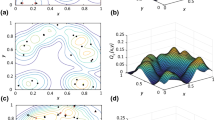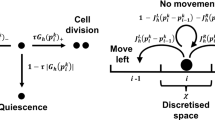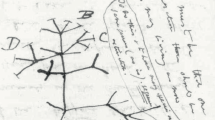Abstract
In this paper we develop a spatially explicit marked point process model to generate spatial patterns of reproducing and moving cells evolving through continuous time. In this context, marked points (i.e. cells) can divide and move as a result of (a) their own growth and division motions, and (b) the division motions and the growth of their touching neighbours. To illustrate such dynamics we present several simulated examples. Our results suggest that by replacing the mathematically convenient growth and interaction functions by others more suited to mimic realistic cell reproduction dynamics, this model may provide a modelling framework to simulate cell aggregate (i.e. tissue) dynamics. Moreover, adding movement to dividing and growing points opens up new areas of application as well as new theoretical problems such as the analysis and generation of dense packing of discs (or spheres).
Similar content being viewed by others
References
Alberts B, Johnson A, Lewis J, Raff M, Roberts K, Walter P (2002) Molecular biology of the cell. Garland, New York
Baserga R (1965) Relationship of cell cycle to tumor growth and control of cell division. Cancer Res 25:581–595
Comas C, Mateu J (2006) On soft and hard particle motions for stochastic marked point processes. J Statist Comput Simul (to appear)
Diggle PJ (2003) Statistical analysis of spatial point patterns, 2nd edn.Edward Arnold, London
DiMilla PA, Barbee K, Lauffenburger DA (1991) Mathematical model for the effects of adhesion and mechanics on cell migration speed. Biophys J 60:15-37
Dubertret B, Rivier N (1997) The renewal of the epidermis: a topological mechanism. Biophys J 73:38–44
Dubertret B, Rivier N (2000)Geometrical models of the renewal of the epidermis. CR Acad Sci III 323:49–56
Granner F, Glazier JA (1992) Simulation of biology cell sorting using a two-dimensional extended Potts model. Phys Rev Lett 69:2013–2016
Honda H(1978)Description of cellular patterns by Dirichlet domains: the two-dimensional case.J Theor Biol 72:523–543
Honda H, Eguchi G (1980) How much does the cell boundary contract in a monolayered cell sheet?. J Theor Biol 84:575–588
Renshaw E, Särkkä A (2001)Gibbs point processes for studying the development of spatial-temporal stochastic processes. shape Comput Statist Data Analy 36:85–105
Ribba B, Saut O, Bresch D, Grenier E, Biossel JP (2006) A multiscale mathematical model of avascular tumor growth to investigate the therapeutic benefit of anti-invasive agents. J Theor Biol 243:532–541
Solé RV (2003) Phase transitions in unstable cancer cell populations. Eur Phys J B 35:117–123
Stein GS, Baserga R, Giordano A, Denhardt DT (1999) The molecular basis of cell cycle and growth control. Wiley-Liss
Stoyan D, Kendall WS, Mecke J (1995)shape Stochastic geometry and its applications. Wiley, New York
Stoyan D (2003). Hard problems with random systems of hard particles. Bulletin of the 54th session of the ISI, 13–20 August, Berlin
Torquato S (2005) Random heterogeneous material. Microstructure and macroscopic properties, 2nd edn. Springer, New York
Author information
Authors and Affiliations
Corresponding author
Additional information
Work partially funded by grant MTM2004-06231 from the Spanish Ministry of Science and Education.
Rights and permissions
About this article
Cite this article
Comas, C., Mateu, J. Growing and reproducing particles evolving through space and time. Metrika 67, 145–169 (2008). https://doi.org/10.1007/s00184-007-0127-6
Received:
Published:
Issue Date:
DOI: https://doi.org/10.1007/s00184-007-0127-6




